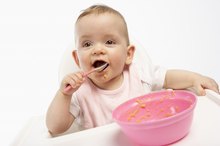4-Month-Baby Diet
At 4 months, your baby's appetite is growing and she's drinking more than she has in the past. For many children, however, the 4-month mark is when their diets begin to change. Depending on her development and your pediatrician's philosophy, your baby may be ready to incorporate new foods into her diet.
Daytime Feedings
At 4 months, your baby is getting all of his nutrients from breast milk or formula. Parenting website BabyCenter.com reports that babies at 4 months can have as many as 10 feedings of breast milk or 40 oz. of formula in a day. If he can handle all of this feeding with no problem, his appetite is healthy and he could be ready to move on to solid foods.
- At 4 months, your baby is getting all of his nutrients from breast milk or formula.
Nighttime Feedings
Can 4-Month-Old Babies Eat Brown Rice?
Learn More
Your 4-month-old baby is getting to the point where she no longer needs to be fed during the night 2. Most babies at this age can last seven or more hours at night without a feeding, according to Texas Children's Pediatric Associates. It's OK if your baby needs more feedings than this, however, you might want to encourage her to sleep later into the night without feedings.
Cereal
At your baby's 4-month checkup, your doctor may recommend that he begin eating solid foods. In most cases, the first solid food he'll have is rice cereal. You'll start by giving him a runny mixture of cereal and formula or breast milk, which will become thicker over time as he gets adjusted to the texture. It may take him some time to get used to this new way of eating, but he'll eventually come to enjoy cereal.
- At your baby's 4-month checkup, your doctor may recommend that he begin eating solid foods.
- You'll start by giving him a runny mixture of cereal and formula or breast milk, which will become thicker over time as he gets adjusted to the texture.
Fruits and Vegetables
When to Start Feeding Baby Stage 3 Gerber Foods
Learn More
When your baby has mastered cereal, she's ready to move onto jarred fruits and vegetables. This is the next step toward getting her to eat table foods. However, at 4 months, pureed fruits and vegetables are merely meant to supplement her diet of formula or breast milk. Stick with one food for a few days so you can see which ones she likes best or may have adverse reactions to.
- When your baby has mastered cereal, she's ready to move onto jarred fruits and vegetables.
- This is the next step toward getting her to eat table foods.
Beyond 4 Months
Once your baby adjusts to solid foods, you can relax for a little while. He'll be having his regular feedings, plus cereal and pureed foods, until he's about 8 months. At that time, he can begin to have the same table foods you eat every day. When he's about a year old, he'll be ready for whole milk and he'll be able to follow a toddler's diet.
- Once your baby adjusts to solid foods, you can relax for a little while.
- When He's about a year old, He'll be ready for whole milk and He'll be able to follow a toddler's diet.
Related Articles
References
- BabyCenter: Age-By-Age Guide to Feeding Your Baby
- KidsHealth: Feeding Your 4- to 7-Month-Old
- Koplin JJ, Allen KJ, Gurrin LC, et al. The impact of family history of allergy on risk of food allergy: a population-based study of infants. Int J Environ Res Public Health. 2013;10(11):5364–5377. Published 2013 Oct 25. doi:10.3390/ijerph10115364
- American Academy of Pediatrics. Infant Food and Feeding. AAP.org. Published 2020.
- American Academy of Pediatrics. Committee on Nutrition. Hypoallergenic infant formulas. Pediatrics. 2000;106(2 Pt 1):346-9. doi:10.1542/peds.106.2.346
- Ferraro V, Zanconato S, Carraro S. Timing of Food Introduction and the Risk of Food Allergy. Nutrients. 2019;11(5):1131. Published 2019 May 21. doi:10.3390/nu11051131
- Cabana MD. The Role of Hydrolyzed Formula in Allergy Prevention. Ann Nutr Metab. 2017;70 Suppl 2:38-45. doi:10.1159/000460269
- National Collaborating Centre for Women's and Children's Health (UK). Identification and management of trigger factors. Atopic Eczema in Children: Management of Atopic Eczema in Children from Birth up to the Age of 12 Years. Published December 2007.
- Abeshu MA, Lelisa A, Geleta B. Complementary Feeding: Review of Recommendations, Feeding Practices, and Adequacy of Homemade Complementary Food Preparations in Developing Countries - Lessons from Ethiopia. Front Nutr. 2016;3:41. Published 2016 Oct 17. doi:10.3389/fnut.2016.00041
- Hagan JF, Shaw JS, Duncan PM. Bright Futures: Guidelines for Health Supervision of Infants, Children, and Adolescents. Elk Grove Village, IL: Bright Futures/American Academy of Pediatrics; 2017.
- NIAID-Sponsored Expert Panel, Boyce JA, Assa'ad A, et al. Guidelines for the diagnosis and management of food allergy in the United States: report of the NIAID-sponsored expert panel. J Allergy Clin Immunol. 2010;126(6 Suppl):S1–S58. doi:10.1016/j.jaci.2010.10.007
- Abrams EM, Becker AB. Food introduction and allergy prevention in infants. CMAJ. 2015;187(17):1297–1301. doi:10.1503/cmaj.150364
- Koo YC, Chang JS, Chen YC. Food claims and nutrition facts of commercial infant foods. PLoS One. 2018;13(2):e0191982. Published 2018 Feb 28. doi:10.1371/journal.pone.0191982
- Van den boom S, Kimber AC, Morgan JB. Nutritional composition of home-prepared baby meals in Madrid. Comparison with commercial products in Spain and home-made meals in England. Acta Paediatr. 1997;86(1):57-62. doi:10.1111/j.1651-2227.1997.tb08833.x
- Caffarelli C, Di Mauro D, Mastrorilli C, Bottau P, Cipriani F, Ricci G. Solid Food Introduction and the Development of Food Allergies. Nutrients. 2018;10(11):1790. Published 2018 Nov 17. doi:10.3390/nu10111790
- Kusari A, Han A, Eichenfield L. Recent advances in understanding and preventing peanut and tree nut hypersensitivity. F1000Res. 2018;7:F1000 Faculty Rev-1716. Published 2018 Oct 30. doi:10.12688/f1000research.14450.1
- Daniels L, Heath AL, Williams SM, et al. Baby-Led Introduction to SolidS (BLISS) study: a randomised controlled trial of a baby-led approach to complementary feeding. BMC Pediatr. 2015;15:179. Published 2015 Nov 12. doi:10.1186/s12887-015-0491-8
- Leung AK, Sauve RS. Whole cow's milk in infancy. Paediatr Child Health. 2003;8(7):419–421. doi:10.1093/pch/8.7.419
- Jeffery LA, Karim S. Botulism. [Updated 2019 Nov 30]. In: StatPearls [Internet]. Treasure Island (FL): StatPearls Publishing; 2019 Jan-.
- Nichols BG, Visotcky A, Aberger M, et al. Pediatric exposure to choking hazards is associated with parental knowledge of choking hazards. International Journal of Pediatric Otorhinolaryngology. 2012;76(2):169-173. doi:10.1016/j.ijporl.2011.10.018.
- Awadalla N, Pham T, Milanaik R. Chew on This: Not All First Finger Foods Are Created Equal. Clin Pediatr (Phila). 2018;57(8):889-894. doi: 10.1177/0009922817733701
- Chan ES, Abrams EM, Hildebrand KJ, Watson W. Early introduction of foods to prevent food allergy. Allergy Asthma Clin Immunol. 2018;14(Suppl 2):57. Published 2018 Sep 12. doi:10.1186/s13223-018-0286-1
- Nwaru BI, Erkkola M, Ahonen S, et al. Age at the Introduction of Solid Foods During the First Year and Allergic Sensitization at Age 5 Years. Pediatrics. 2009;125(1):50-59. doi:10.1542/peds.2009-0813.
Writer Bio
Bryan Berg is a freelance writer based in Long Island, NY. He has been writing since 2002 about personal finance, sports and parenting. He is a contributing writer to eHow Money and LIVESTRONG.COM. He has a Bachelor of Arts in marketing from Hofstra University.









